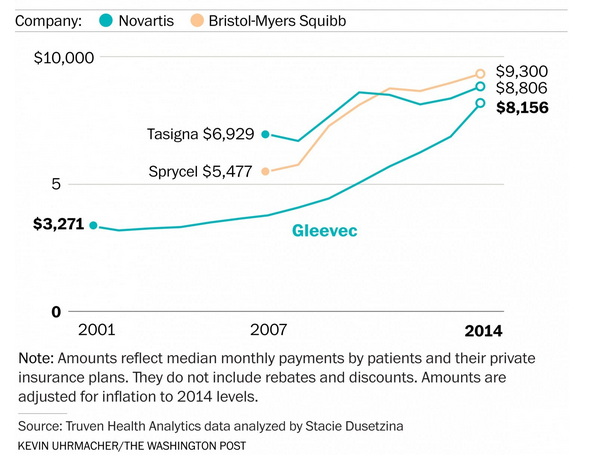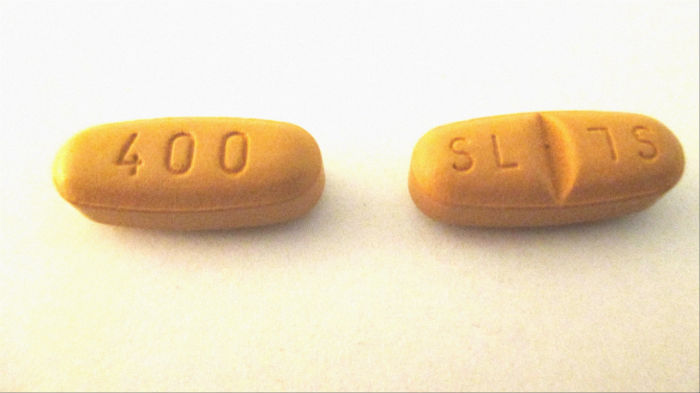by Gabriel Levitt, President, PharmacyChecker.com and Prescription Justice | Jul 20, 2016 | Advocacy, Cancer Drugs, Drug Prices

The problem is just getting worse.
I’m pleading guilty to plagiarism here…well, kind of. I lifted this blog post’s title from the lead section in an article by Brad Tuttle last week in Time.com – called, “Prescription Drug Prices in America Are Rising Like No Other Industry.” The gist of the article is one we’re familiar with: drug price inflation is a major aberration in the U.S. economy, increasing about 10% a year for the past three years. Compare that to general inflation, which is historically, exceedingly low – averaging about 1% for the past three years.
You can read the aforementioned article for yourself — but what really jumped out at me was the discovery of another piece by Mr. Tuttle called “21 Incredibly Disturbing Facts about High Drug Prices” from this past June. Here are the top three fact (of the 21) that resonate loudest with me and why they do. (more…)
Tagged with: Time.com, tuttle
by Tod Cooperman, M.D., CEO, PharmacyChecker.com | Mar 31, 2016 | Cancer Drugs, Drug Prices
There has been a lot of news this week about the outrageously high cost of Xtandi, a drug for advanced prostate cancer. Although developed with funding from the U.S. National Institutes of Health (NIH), Xtandi (enzalutamide) is being sold to Americans at about four times the price at which it is sold in other countries. In January, a petition was sent to have the U.S. government step in and require that Xtandi be priced more fairly for Americans. More recently, several congresspeople and senators, including Bernie Sanders, reiterated this request with their own letter to the Secretary of Health and Human Services and the Director of the NIH.
According to the petition, the Japanese company licensed to sell Xtandi, Astellas Pharma Inc., and its U.S. marketing partner, Medivation Inc. charge an average wholesale price of $88.48 per 40 mg capsule in the U.S. However, in Japan the price is just $26.37, in Australia, it is $23.46, and just across the border in Canada the price is only $20.12.
If you only had to take a few capsules of Xtandi for a short time, this might not be such a big deal. But a standard dose of Xtandi is 4 capsules per day for months at a time. That’s 120 pills per month. So the cost of just a one-month supply of 120 pills at the average wholesale price is $10,617. That’s right, over $10,000 per month! If you must get Xtandi and you don’t have insurance which covers it, what are you to do?
First, if you have no insurance or poor insurance and a household income of $100,000 or less, you can apply to get Xtandi for free through Astellas, which may also offer other financial support.
If that doesn’t work for you, another less expensive option (short of travelling to another country) would be to order Xtandi from a verified international online pharmacy, which will send the medication to you from a licensed pharmacy in another country, such as Canada. Currently, several PharmacyChecker.com-verified online pharmacies sell Xtandi for about $41 per 40 mg capsule – about half the cost in the U.S. If you prefer to get your medication from a U.S. pharmacy, many pharmacies offer or accept discount cards which can bring the cost down a little, but only to about $75 per capsule.
It is ridiculous that American taxpayers helped develop this drug but are charged the most to get it. Hopefully, things will change.
Tagged with: Astellas, Cancer medication, Drug Prices, government, Online Pharmacies, prostate cancer, Xtandi
by Gabriel Levitt, President, PharmacyChecker.com and Prescription Justice | Mar 11, 2016 | Cancer Drugs, Drug Prices
An article in the Washington Post yesterday covered the steep rise in the cost of a cancer medication called Gleevec, drug company Novartis’ brand name for imatinib, which is incredibly successful in treating people with chronic myeloid leukemia (CML). Despite its concern with public perception over price at the time, Novartis charged $26,400/year when the drug hit the market in 2001. With today’s price for Gleevec now $126,000/year it seems any concerns by Novartis have gone by the wayside (or did they really exist at all?). One would think and hope that new, similar products would bring down – or at least slow increases of – the price of Gleevec. After all, competition is supposed to drive down prices.
Not in the pharmaceutical industry, at least not until a drug goes off patent. The launch of therapeutically equivalent brand medications to treat CML actually coincided with Gleevec’s steepest price increases. Bristol-Myers Squibb launched Sprycel (dasatinib) in 2006 and Novartis launched a second generation drug called Tasinga (nilotinib) in 2007, both at much higher prices than Gleevec. In 2007, the monthly prices for Gleevec, Sprycel and Tasinga were $3,757, $5,477 and $6,929, respectively. The details can be found in the Post’s article but essentially Gleevec started to play “catch up” to its competitors.
In 2007, the price of Gleevec was 46% less than Tasinga. By 2014, the discount had shrunk to 12% with Gleevec’s price at $8,156/month compared to Tasinga’s price of $9,300/month. Let’s keep in mind that the newer drugs were shown to treat people that Gleevec could not treat, which would soften the argument that these are truly competing products. But soon after their introduction, Sprycel and Tasinga were found to successfully treat people with newly diagnosed cases of CML, to more directly compete with Gleevec, yet the latter’s price soared!
Source: Graph below from the Washington Post.

One source cited in the post’s article summed it up perfectly. A hematologist from the University of Chicago, Richard Larson, stated: “Ordinarily, you might think with three equally effective drugs on the market, the price should go down through competition, but it’s been a failure of the competitive pricing process.”
While the Washington Post’s article delved into the problem of out of pocket costs for Gleevec, it didn’t hammer home that the suffering in America is extreme when it comes to Gleevec’s drug price (and other medication prices as well). Gleevec is not a new topic on these blog pages, which has solicited comments from people and families crushed by drug costs. Yes, the irony is glaring: cancer medications that alleviate suffering also create suffering, too, in the form of cancer patients facing bankruptcy, feeling guilt, and causing anxiety.
It’s not just market failure – it is greed, too. I’ll let one American, Penny Kincaid, a commenter on this blog, bring it home:
“I guess I am luckier than many on Gleevec. I am paying 5% of the cost each month but the cost keeps going up. Our lives depend on this drug but still the cost is obscene. They praise themselves for creating [these] drugs for patients with [CML] but still we are forced to pay and many go broke. It is the cancer patient who has to pay up or die and they keep raising the cost. This is just wrong in so many ways and here we have the creators wanting to deny us the generic because they want that big money to keep rolling in. They should be ashamed of themselves.”
Tagged with: Bristol Myers Squibb, chronic myeloid leukemia, Drug Prices, Gleevec, leukemia, novartis, Sprycel, Tasinga
by Gabriel Levitt, President, PharmacyChecker.com and Prescription Justice | Aug 12, 2015 | Advocacy, Cancer Drugs, Counterfeit Drugs, Drug Importation, FDA, Government, Personal Drug Importation
Almost three years ago, we blogged about a federal investigation of CanadaDrugs.com, which for many years has safely sold prescription medication at prices far lower than typically available in the U.S, and which is a verified online pharmacy in the PharmacyChecker.com Verification Program. The investigation focused on CanadaDrugs.com’s wholesale drug importation and distribution to doctors and clinics — an area CanadaDrugs.com has long since exited. It did not focus on CanadaDrugs.com’s retail sales to consumers for personal use, which is the focus of the PharmacyChecker.com Verification Program and the information we provide to consumers on our website about online pharmacies.
Recently, an indictment was unsealed in federal district court in Montana that charged CanadaDrugs.com, Ltd. (the entity which owns CanadaDrugs.com) and others with illegal wholesale drug importation, which allegedly occurred between three to six years ago. The allegations include wholesale distribution of a counterfeit version of the cancer drug Avastin to medical clinics in the U.S.
The indictment of CanadaDrugs, Ltd, comes as no surprise, as the investigation was well publicized. It will also come as no surprise, however, when the U.S. pharmaceutical industry tries to use the charges, which focus exclusively on wholesale drug importation, in an effort to discredit safe personal drug importation. As we have written here and opined in the New York Times, the U.S. pharmaceutical industry and pharmacy chains feel threatened because Americans can and do safely purchase their medications online at substantially lower cost from pharmacies in other countries. Thus, the industry, the “non-profit” groups it funds, and the government agencies which it lobbies and seeks to influence, will see this indictment as yet one more opportunity to scare people from personal drug importation. This slight of hand is wrong, since the investigation and indictment have nothing to do with personal drug importation. In fact, even the Wall Street Journal, which was instrumental in publicizing the investigation, clarified the difference between wholesale businesses and CanadaDrugs.com: “There is no indication that fake medicines were sold through the company’s consumer-focused website, CanadaDrugs.com.”
(more…)
Tagged with: avastin, canadadrugs, kamath, montana
by Gabriel Levitt, President, PharmacyChecker.com and Prescription Justice | Jul 24, 2015 | Advocacy, Cancer Drugs, Government, Personal Drug Importation, Pharmaceutical Industry, Policy
Yesterday, in the New York Times, Andrew Pollack reported on the swelling chorus of groups, politicians, and consumers who are sickened by the price of cancer drugs and medication costs generally. They are calling for pharmaceutical companies to justify the outrageous costs of medication.
As part of this swell of frustration and anger about drug prices, over 100 oncologists are calling for the U.S. government to take concrete steps to bring down the prices on expensive cancer medications, many which cost over $100,000/year. One of those steps is allowing importation of cancer drugs across borders for personal use. (What a novel idea!). Despite the federal restrictions on the practice, five million Americans already import prescription drugs for personal use because the costs of medicine are too high domestically. The imports help people afford medications that they would otherwise go without. While people are not prosecuted for doing so as long as the imports are for personal use, expressly legalizing safe prescription importation from licensed pharmacies in other countries is a great idea for all medications, not just cancer medications, and would probably cause medication prices to fall at U.S. pharmacies.
Personal drug importation is just one step among several that doctors are calling on to improve access to affordable cancer medication. Others include allowing Medicare to negotiate drug prices like the Veteran’s Administration does; banning deals (“pay-to-delay”) between brand and generic drug companies, in which the former pays off the latter to postpone introducing a lower cost generic drug; and reigning in patent terms so that lower cost generics can come to market faster.
In reading the New York Times article, the tone of criticism reported on was veering toward visceral disgust that so many seem to have with the pharmaceutical industry. But the Wall Street Journal was on this issue, too. In “Doctors Object to High Cancer Drug Prices,” Jeanne Whalen writes: “The doctors focus attention on the financial burden to patients, saying the out-of-pocket costs are bankrupting many just as they’re fighting a deadly illness.”
To conclude, recall that last month we brought you a real story of an American family facing financial ruin due to the cost of a cancer medication. Lisa wrote:
“We are going broke, will probably lose our home and my husband will probably never be able to retire (even though his body is breaking down from 40+ years of a very physical job as a pipe fitter. I (the wife), am permanently disabled. We will die homeless before this drug ever comes within an affordable price.
“Why doesn’t anyone bring this to the press? Why does Congress and Obamacare turn a blind eye? How many hundreds have to die before this drug and options are researched.”
The media coverage mentioned in this post shows that people are bringing this to the press. It’s exactly the press coverage that Lisa and her family deserve, not to mention the tens of millions of Americans who don’t fill prescriptions each year because of cost! Now will the government do something or are they too under the yoke of the pharmaceutical industry lobbying juggernaut?
by Gabriel Levitt, President, PharmacyChecker.com and Prescription Justice | Jun 24, 2015 | Cancer Drugs
This blog post concerns real people who are desperate, angry, and facing terminal illness because of the cost of a cancer medication. A woman named Lisa recently placed a comment on a blog post we wrote back in March 2013 called “The Price of Gleevec: A Tale of Two Supreme Courts.” We noted at the time that the Indian Supreme Court told drug company Novartis to go fly a kite in its effort to stop lower cost generic versions of Gleevec, a cancer medication, from being sold in India, and that the U.S. Supreme Court was hearing arguments against a practice known as Pay-to-Delay involving a different medication.
But this post is not about policies and intellectual property or patent rights, the rightness or wrongness of India’s looser patent laws, pay-to-delay, personal drug importation or online pharmacies. It’s just about a woman’s husband and others who have cancer and can’t afford the medicine they need to get better or live.
Lisa gave me permission to re-publish her comment as a blog post here. I have made very, very slight edits, as you can see if you look at the original comment.
Lisa wrote:
This is very interesting news and gives us a little hope. My husband has Chronic Myeloid Leukemia (CML). He has been on Gleevec (here in So. California for the past 12 years. I thought I should mention Gleevec here in the U.S. is $10,600.00 a month for 400mg (30 pills). I thought should mention this because your prices listed here in the U.S. are inaccurate. That would bring the total cost to $126,000 a year.
We are going broke, will probably lose our home and my husband will probably never be able to retire (even though his body is breaking down from 40+ years of a very physical job as a pipe fitter. I (the wife), am permanently disabled. We will die homeless before this drug ever comes within an affordable price.
Many children and adults are cutting their pills in half, which defects the purpose. They too, will die before seeing Gleevec reach an affordable price here in the U.S.
All the countries you listed in the article, do NOT accept U.S. insurance companies and/or ObamaCare.
Why doesn’t anyone bring this to the press? Why does Congress and ObamaCare turn a blind eye? How many hundreds have to die before this drug and options are researched. I have written many letters to Norvartis, only to be ignored. I have written to Media Outlets only to be ignored. Now I am desperately asking for your help in bringing this to the media and anyone that will listen. We and many others are scared out of our minds. We are really loosing hope and it is tearing families apart. Some patients are becoming suicidal, because they don’t know how they are going to afford the next month supply of Gleevec. Novartis (GREEDARTIS) should be ashamed of themselves. You should research the substantial increases (quarterly), since the drug first went on the market. It will blow you mind! What if this was your child or loved one?
Tagged with: Gleevec, lisa, novartis






